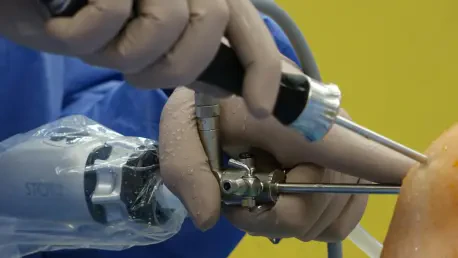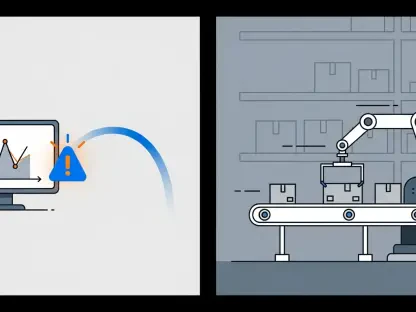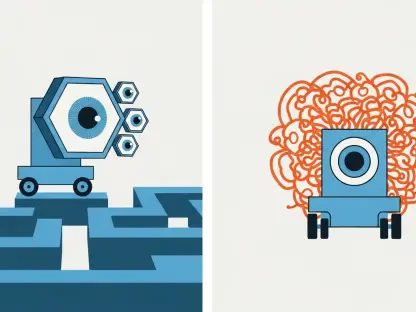In a world where medical technology is advancing at an unprecedented pace, the introduction of a groundbreaking innovation by Valens Semiconductor is turning heads in the healthcare sector, promising to reshape the landscape of medical imaging. The VA7000 chipset, initially engineered for automotive applications, has now been adapted to power next-generation endoscopes. This technology is not merely an incremental upgrade but a bold step forward, addressing some of the most pressing challenges in endoscopy, such as infection risks and diagnostic precision. With its ability to deliver high-speed connectivity and crystal-clear visuals, the VA7000 stands poised to enhance patient safety while streamlining surgical workflows. As the medical field grapples with the dual demands of innovation and safety, this chipset emerges as a beacon of progress, offering a glimpse into a future where procedures are safer, more accurate, and less invasive. The implications of this development ripple far beyond the operating room, touching on economic, societal, and technological dimensions that could redefine healthcare delivery for years to come.
Technical Innovation and Capabilities
Advancing Endoscopic Imaging
The VA7000 chipset represents a leap in endoscopic technology, primarily through its capacity to support multi-gigabit connectivity and deliver high-resolution 4K video over ultra-thin cables. This capability ensures that medical professionals can view intricate details during procedures with unparalleled clarity, a critical factor in complex surgeries. Beyond resolution, the chipset incorporates electrosurgical noise cancellation, a feature that maintains image stability even amidst electromagnetic interference common in surgical environments. Its compact form factor and low power consumption further make it an ideal fit for the design of modern, miniaturized medical devices. By simplifying system architecture and potentially eliminating the need for in-camera image signal processing, the VA7000 reduces both complexity and cost for manufacturers, paving the way for broader adoption in the industry. This fusion of advanced features positions the chipset as a cornerstone for the next wave of imaging tools, fundamentally enhancing how endoscopic procedures are performed.
Another key aspect of the VA7000’s technical prowess lies in its adaptability from automotive to medical applications, showcasing remarkable versatility. Originally designed for high-speed data transmission in Advanced Driver-Assistance Systems, the chipset’s transition to healthcare highlights its robust engineering. The ability to handle demanding data streams without compromising on size or efficiency addresses a long-standing bottleneck in creating disposable endoscopes that don’t sacrifice quality. This innovation enables the production of devices that are not only high-performing but also user-friendly for clinicians, reducing fatigue during lengthy procedures. Additionally, the technology supports seamless integration with existing systems, ensuring that hospitals and clinics can adopt it without overhauling their infrastructure. This balance of cutting-edge performance and practical implementation underscores the chipset’s potential to become a standard in medical imaging technology.
Pushing Boundaries of Device Design
Delving deeper into the VA7000’s impact, its role in enabling miniaturization cannot be overstated. As the medical field increasingly prioritizes less invasive procedures, the demand for smaller, more agile instruments has surged. The chipset’s small footprint and efficient power usage make it possible to design endoscopes that are slimmer and more maneuverable, improving access to hard-to-reach areas of the body. This advancement translates to reduced patient discomfort and faster recovery times, aligning with broader trends in patient-centered care. Moreover, the technology’s ability to maintain high-quality imaging in such compact designs ensures that precision isn’t compromised for size, a critical consideration for surgical outcomes. The VA7000 thus serves as a catalyst for reimagining how endoscopic tools are built, opening doors to innovations that were previously constrained by technical limitations.
Equally significant is the chipset’s contribution to cost-effective design solutions for medical device manufacturers. By streamlining the internal architecture of endoscopes, the VA7000 lowers production expenses without sacrificing performance, a factor that could democratize access to advanced tools across healthcare facilities of varying budgets. This cost efficiency is particularly vital in the context of disposable devices, where affordability often determines market penetration. The technology also reduces the need for frequent maintenance or complex calibration, further driving down operational costs for hospitals. As a result, the VA7000 not only enhances the technical capabilities of endoscopes but also reshapes the economic framework within which these devices are developed and deployed, fostering a more sustainable model for medical technology innovation.
Patient Safety and Clinical Outcomes
Tackling Infection Risks
One of the most pressing issues in endoscopy has been the risk of healthcare-associated infections stemming from reusable devices, a challenge the VA7000 chipset directly confronts. Historically, inadequate sterilization of these instruments has led to significant patient harm, prompting regulatory bodies like the FDA to advocate for single-use alternatives. The VA7000 enables the creation of disposable endoscopes that match or exceed the imaging quality of their reusable counterparts, thus mitigating infection risks without compromising on diagnostic accuracy. This shift could drastically reduce the incidence of infections, which not only saves lives but also cuts down on the substantial costs associated with treating such complications. By aligning with regulatory pushes for safer medical practices, the chipset addresses a critical public health concern, marking a turning point in how endoscopic safety is approached.
Beyond the immediate reduction in infection risks, the adoption of VA7000-powered disposable endoscopes has broader implications for hospital protocols and patient trust. Single-use devices eliminate the variability and potential human error involved in reprocessing, ensuring a consistent standard of safety across procedures. This reliability can enhance patient confidence in medical interventions, as the fear of cross-contamination diminishes. Furthermore, healthcare facilities stand to benefit from streamlined workflows, as the time and resources spent on sterilization are redirected to direct patient care. The technology’s role in fostering a safer clinical environment extends to protecting healthcare workers as well, reducing their exposure to contaminated equipment. This comprehensive impact on safety underscores the VA7000’s value as more than just a technical innovation, but as a cornerstone of improved healthcare delivery.
Enhancing Diagnostic Precision
The VA7000’s contribution to clinical outcomes is equally notable in its enhancement of diagnostic precision through superior imaging capabilities. High-resolution 4K video feeds provide clinicians with detailed visuals, allowing for earlier and more accurate detection of abnormalities during endoscopic examinations. This improved visibility is crucial in identifying conditions that might be missed with lower-quality imaging, directly impacting treatment plans and patient prognosis. The stability of the video stream, even under challenging surgical conditions, further ensures that critical moments aren’t obscured by interference, enabling real-time decision-making. Such advancements empower medical professionals to deliver more effective care, potentially reducing the need for follow-up procedures and improving overall efficiency in diagnostic processes.
Additionally, the chipset’s impact on clinical outcomes extends to surgical precision during therapeutic interventions. Clearer imaging supports better navigation and manipulation within the body, minimizing the risk of unintended damage to surrounding tissues. This precision is particularly vital in delicate procedures where margins for error are slim, such as in gastrointestinal or respiratory surgeries. The technology also facilitates better documentation of procedures through high-quality recordings, which can be invaluable for training, legal, or research purposes. By elevating the standard of visualization, the VA7000 not only enhances immediate patient outcomes but also contributes to the long-term advancement of medical knowledge and practice, reinforcing its transformative role in the field of endoscopy.
Market Impact and Economic Potential
Disrupting the Medical Device Landscape
Valens Semiconductor’s foray into the medical imaging sector with the VA7000 chipset is poised to disrupt the competitive dynamics of the medical device industry. With the market for disposable endoscopes projected to grow into billions over the coming years, the technology taps into a significant economic opportunity. Early adoption by several original equipment manufacturers signals strong market validation, as these partners roll out innovative products like 4K single-use colonoscopes and 3D imaging solutions for robotic surgeries. For Valens, this expansion represents a diversification beyond its traditional automotive focus, opening a lucrative new revenue stream. Meanwhile, traditional manufacturers of reusable endoscopes face mounting pressure to adapt or risk losing ground to competitors leveraging disposable, high-performance alternatives enabled by the VA7000.
The ripple effects of this disruption extend to how medical device innovation is prioritized within the industry. The VA7000 lowers technical and financial barriers for manufacturers, enabling faster development cycles and quicker time-to-market for cutting-edge products. This agility can reshape competitive hierarchies, as smaller or emerging companies gain the ability to challenge established players with advanced, cost-effective solutions. Additionally, the technology’s alignment with regulatory trends favoring single-use devices positions adopting manufacturers as leaders in compliance and safety, enhancing their market reputation. The economic landscape of medical imaging is thus undergoing a significant shift, with the VA7000 acting as a catalyst for broader industry transformation and intensified competition.
Driving Economic Accessibility
A critical dimension of the VA7000’s market impact is its potential to drive economic accessibility to advanced medical technology. By reducing the cost and complexity of designing high-quality disposable endoscopes, the chipset makes it feasible for a wider range of healthcare facilities to adopt state-of-the-art tools. This is particularly impactful in regions or institutions where budget constraints have historically limited access to cutting-edge equipment, allowing for more equitable distribution of high-standard care. The affordability factor also benefits patients indirectly, as lower production costs could translate to reduced procedure expenses over time, easing the financial burden on healthcare systems and individuals alike. This democratization of technology stands as a testament to the chipset’s broader economic value.
Moreover, the economic potential of the VA7000 extends to fostering innovation ecosystems within the medical device sector. As manufacturers integrate this technology, they are likely to invest in complementary advancements, spurring job creation and research opportunities. The chipset’s ability to support scalable production also means that supply can meet growing demand without significant price hikes, ensuring market stability. For Valens Semiconductor, the success of the VA7000 in this domain could pave the way for further cross-industry applications, amplifying its economic footprint. This intersection of innovation and accessibility highlights how a single technological breakthrough can generate widespread benefits, reshaping not just market dynamics but also the economic framework of healthcare delivery on a global scale.
Future of Healthcare Technology
Synergy with AI and Smart Devices
Looking ahead, the VA7000 chipset is set to play a pivotal role in the integration of artificial intelligence into medical applications, unlocking new frontiers in healthcare technology. The high-quality, stable 4K video feeds it provides serve as an ideal data source for AI algorithms, enabling real-time diagnostic assistance and enhancing the accuracy of anomaly detection during procedures. This synergy is particularly promising for robotic surgery systems, where precise, data-driven guidance can significantly improve outcomes. The chipset’s robust connectivity ensures that AI systems receive consistent, high-fidelity inputs, a prerequisite for reliable performance in critical medical settings. As AI continues to evolve, the VA7000 positions itself as a foundational hardware component, bridging the gap between advanced sensors and intelligent processing to transform how surgeries and diagnostics are conducted.
The potential for “smart” endoscopes powered by the VA7000 further amplifies its future impact, pointing to a new era of multifunctional medical devices. Beyond imaging, these tools could incorporate capabilities like chemical analysis or localized drug delivery, expanding the scope of minimally invasive procedures. Such innovations could reduce the need for multiple interventions, streamlining patient care while minimizing risks. The chipset’s ability to support complex data transmission in a compact design makes these futuristic applications not just theoretical but increasingly viable. This convergence of hardware and software innovation hints at a healthcare landscape where technology anticipates clinical needs, offering solutions that are as proactive as they are precise, and setting a new standard for medical advancements.
Shaping Minimally Invasive Medicine
The VA7000’s influence on the future of minimally invasive medicine is another area of profound significance, aligning with the industry’s push for less invasive, more patient-friendly approaches. Its compact design and high-performance capabilities enable the development of specialized endoscopes tailored for diverse applications, from bronchoscopy to ureteroscopy, each with enhanced visualization and maneuverability. This adaptability ensures that a wider range of conditions can be addressed through smaller incisions or natural orifices, reducing trauma and accelerating recovery for patients. The technology’s role in miniaturization also supports the creation of portable or handheld devices, potentially expanding access to advanced care in remote or underserved areas. This trend toward less invasive tools is poised to redefine surgical norms over the coming years.
Equally important is the chipset’s capacity to drive long-term advancements in intelligent, data-driven operating environments. As hospitals adopt VA7000-powered devices, the integration of real-time analytics and machine learning could transform operating rooms into hubs of predictive and personalized medicine. Surgeons might receive instant feedback on procedural risks or patient vitals, enhancing decision-making under pressure. While challenges like regulatory navigation and cost management persist, the trajectory suggests a decade of progress where minimally invasive techniques become the default rather than the exception. Reflecting on the strides made with the VA7000, it’s evident that this technology laid a critical foundation for safer, smarter healthcare, inspiring a wave of innovation that reshaped patient care and clinical practice for generations.









